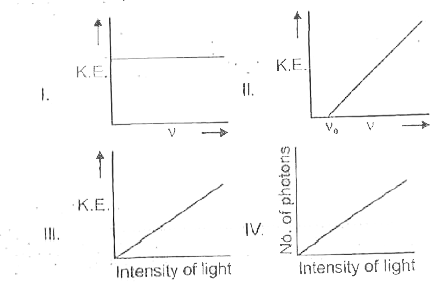can X-rays be used for photoelectric effect?
To determine whether X-rays can be used for the photoelectric effect, we can follow these steps:
Step 1: Understand the Photoelectric Effect
The photoelectric effect is the phenomenon where electrons are emitted from a metal surface when it is exposed to light or electromagnetic radiation of sufficient frequency. The key condition is that the frequency of the incoming radiation must be greater than a certain threshold frequency (denoted as V0) specific to the material.
Hint: Recall the definition of the photoelectric effect and the importance of the threshold frequency.
Step 2: Identify the Relationship Between Frequency and Energy
The energy of a photon is given by the equation:
E=hV
where E is the energy of the photon, h is Planck's constant, and V is the frequency of the radiation. For the photoelectric effect to occur, the energy of the incoming radiation must be greater than the work function (ϕ) of the metal.
Hint: Remember the equation that relates energy and frequency, and consider how it applies to different types of radiation.
Step 3: Determine the Energy of X-rays
X-rays have a high frequency, typically ranging from 1016 Hz to 1019 Hz. This high frequency corresponds to a significant amount of energy, which can be calculated using the energy equation from Step 2.
Hint: Think about the range of frequencies for X-rays and how they compare to the threshold frequency of metals.
Step 4: Compare X-ray Energy to Work Function
Since the energy of X-rays is generally much greater than the work function of most metals, it can be concluded that X-rays can indeed provide enough energy to overcome the work function and cause the emission of electrons.
Hint: Consider the typical values of work function for metals and compare them to the energy of X-rays.
Step 5: Conclusion
Based on the above analysis, we conclude that X-rays can be used for the photoelectric effect because their energy is sufficient to exceed the work function of metals.
Final Answer: Yes, X-rays can be used for the photoelectric effect.
The photoelectric effect is the phenomenon where electrons are emitted from a metal surface when it is exposed to light or electromagnetic radiation of sufficient frequency. The key condition is that the frequency of the incoming radiation must be greater than a certain threshold frequency (denoted as V0) specific to the material.
The energy of a photon is given by the equation:
E=hV
where E is the energy of the photon, h is Planck's constant, and V is the frequency of the radiation. For the photoelectric effect to occur, the energy of the incoming radiation must be greater than the work function (ϕ) of the metal.
X-rays have a high frequency, typically ranging from 1016 Hz to 1019 Hz. This high frequency corresponds to a significant amount of energy, which can be calculated using the energy equation from Step 2.
Since the energy of X-rays is generally much greater than the work function of most metals, it can be concluded that X-rays can indeed provide enough energy to overcome the work function and cause the emission of electrons.
Based on the above analysis, we conclude that X-rays can be used for the photoelectric effect because their energy is sufficient to exceed the work function of metals.
Topper's Solved these Questions
Similar Questions
can X-rays be used for photoelectric effect?
View SolutionWhich is the graph with respect to photoelectric effect?
View SolutionWhich is / are incorrect observations related to photoelectric effect ?
View SolutionWhich is the correct graphical representation based on photoelectric effect ?

View SolutionThe critical wavelength for producing photoelectric effect in a metal is 2500Å What wavelength would be nuccesary be produce photoelectric effect from this metal , having twice the KE of these produced at 2000Å
View SolutionWrite Einstein's photoelectric equation.
Write the three salient features observed in photoelectric effect which can be explained using this equation.
View SolutionWave nature of light cannot explain photoelectric effect because in photoelectric effect , it is seen that
View SolutionLi is used in photoelectric cells.
View SolutionThreshold wavelength for photoelectric effect on sodium is 5000Å . Its work function is
View SolutionIf the threshold frequency of a metal for photoelectric effect is v0 then which of the following will not happen ?
View Solution
